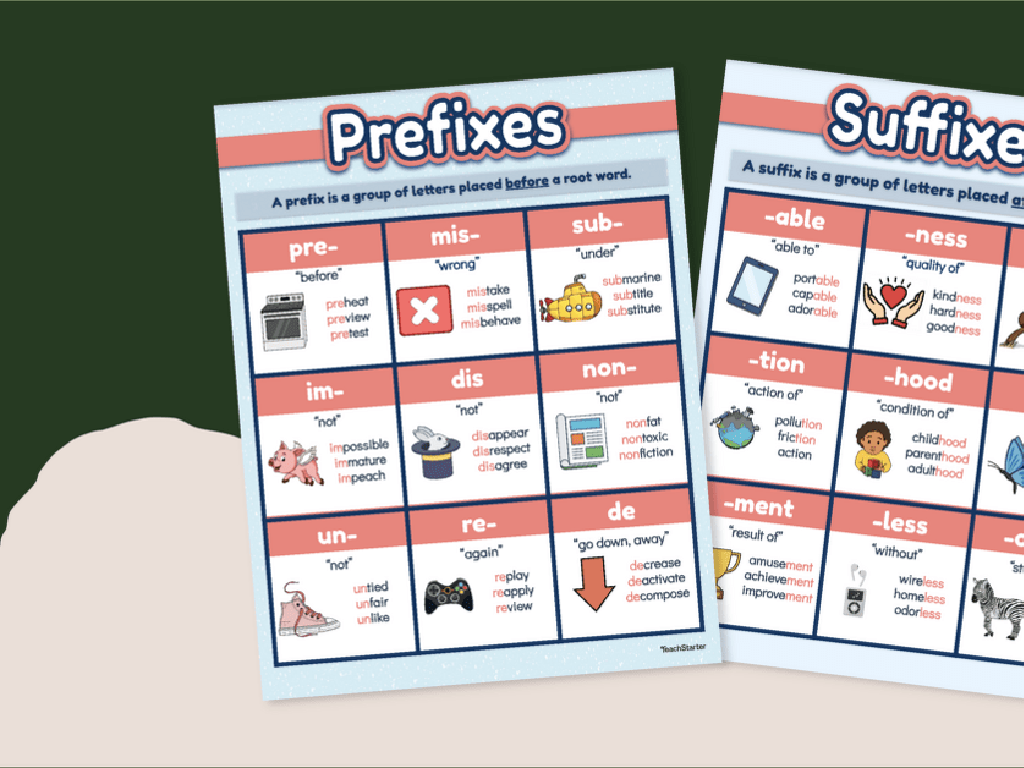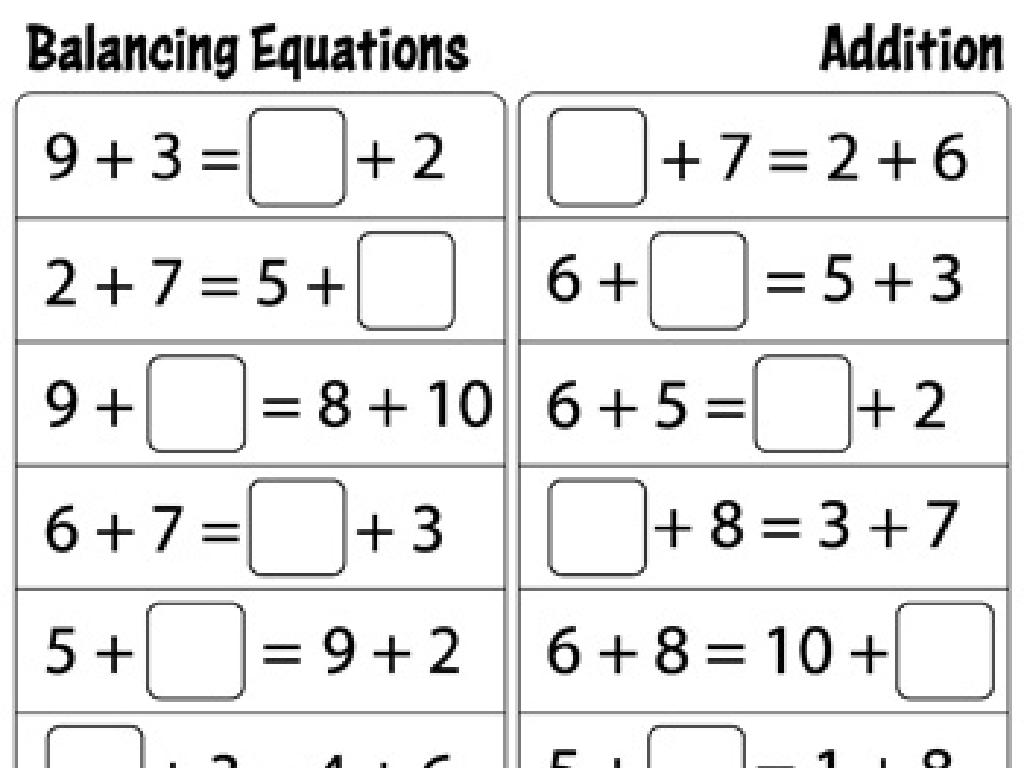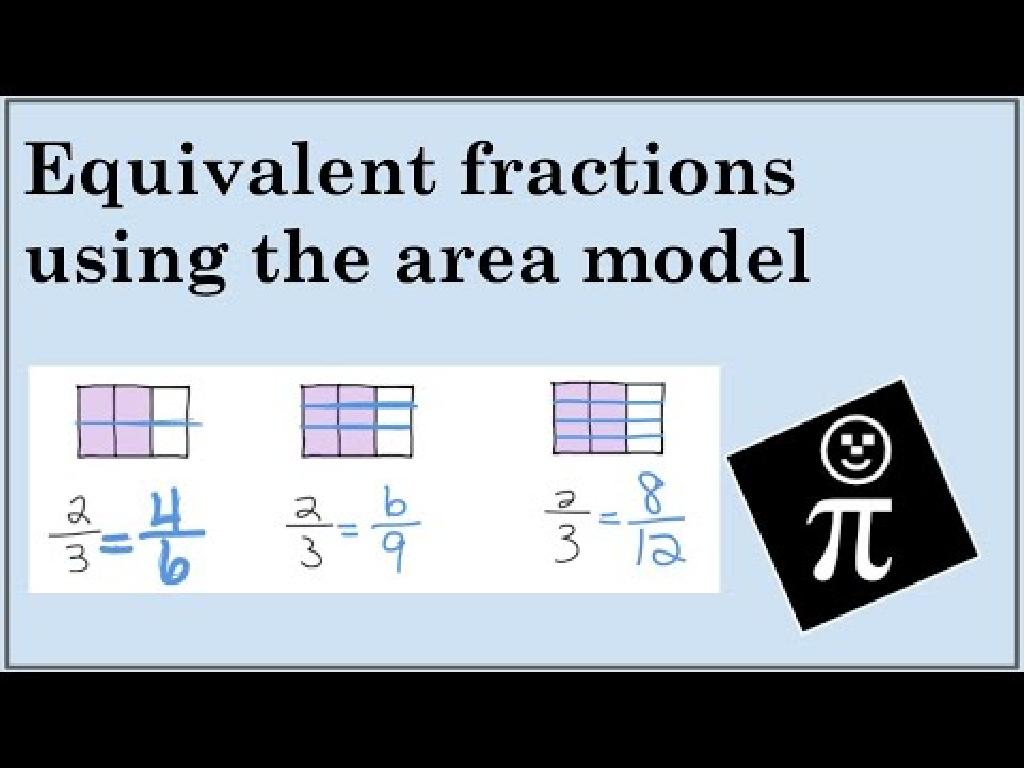Sort Words With Shared Prefixes And Suffixes By Meaning
Subject: Language arts
Grade: Third grade
Topic: Prefixes And Suffixes
Please LOG IN to download the presentation. Access is available to registered users only.
View More Content
Exploring Prefixes and Suffixes
– What are prefixes and suffixes?
– Prefixes are added to the beginning of a word, suffixes at the end.
– Prefixes/suffixes affect meaning
– They change the meaning of the base word, e.g., ‘happy’ to ‘unhappy’.
– Spelling clues from prefixes/suffixes
– Knowing them helps us guess how to spell words.
– Share words with prefixes/suffixes
|
Introduce the concept of prefixes and suffixes to the students, explaining that prefixes are added to the start of words to change their meaning, while suffixes are added to the end. Discuss how these can help with understanding the meaning of new words and improve spelling skills. Engage the class by asking them to participate and share any words they know that contain a prefix or suffix. This will help to create a connection with their existing vocabulary and the new concept being introduced. Encourage them to think about how the prefix or suffix alters the meaning from the original word.
Exploring Prefixes in Words
– What are prefixes?
– Prefixes are letter groups added to word starts.
– Prefixes change word meanings
– They turn ‘happy’ to ‘unhappy’, meaning not happy.
– Examples: ‘un-‘, ‘re-‘
– ‘un-‘ means not, ‘re-‘ means again, like in ‘redo’.
– Class activity: Find more examples
|
This slide introduces the concept of prefixes to the students. Explain that prefixes are a group of letters placed before the root of a word to alter its meaning. Provide clear examples such as ‘un-‘ meaning ‘not’ or ‘re-‘ meaning ‘again’. After explaining, engage the class in an interactive activity where they come up with additional examples of words with prefixes. This activity will help reinforce their understanding of how prefixes change the meanings of words. For the activity, consider breaking the class into small groups and have each group think of words with common prefixes like ‘dis-‘, ‘pre-‘, and ‘mis-‘. Encourage them to use a dictionary if they’re unsure about the meanings.
Exploring Suffixes
– What are suffixes?
– Suffixes are added to word ends
– Suffixes change meaning
– They turn ‘hope’ to ‘hopeful’, altering its meaning
– Examples: ‘-ful’, ‘-ness’
– ‘Hopeful’ shows having hope, ‘kindness’ means being kind
– Let’s find more examples!
|
This slide introduces the concept of suffixes to third-grade students. Begin by explaining that suffixes are groups of letters added to the end of words to change their meaning or part of speech. Provide clear examples like ‘-ful’ in ‘hopeful’, which turns the noun ‘hope’ into an adjective meaning ‘full of hope’, and ‘-ness’ in ‘kindness’, which turns the adjective ‘kind’ into a noun meaning ‘the state of being kind’. Encourage the students to think of other words they know and see if they can identify the suffixes and how they change the meaning. This activity will help them understand how suffixes work and expand their vocabulary. For the next class, prepare a list of common suffixes and plan an interactive activity where students can match suffixes to root words to create new words.
Sorting Words by Prefixes
– Group words by prefixes
– Example: Words with ‘dis-‘
– ‘dis-‘ means not or opposite of, as in ‘dislike’ or ‘discover’
– Activity: Prefix word sort
– Sort given words into groups based on their prefixes
– Understanding prefix meanings
– Knowing prefixes helps guess word meanings
|
This slide introduces the concept of prefixes to the students and how they can be used to sort words into groups. Prefixes are letters added to the beginning of a word that change its meaning. For example, ‘dis-‘ is a prefix that often means ‘not’ or ‘opposite of.’ During the activity, students will practice this concept by sorting a list of words on the board into groups based on their prefixes. This will help them understand how prefixes affect the meaning of words and improve their vocabulary. For the activity, prepare a list of words with common prefixes like ‘un-‘, ‘re-‘, and ‘dis-‘. Divide the board into sections for each prefix and let students come up and place words in the correct section. This interactive activity will engage the students and reinforce their understanding of prefixes.
Sorting Words by Suffixes
– Group words by suffixes
– Suffixes are word endings that change a word’s meaning
– Example: Words ending in ‘-ly’
– ‘Quickly’ means doing something fast, ‘happily’ means doing something with joy
– Activity: Sort words with suffixes
– Find words in a story or list and sort them based on their suffixes
|
This slide introduces the concept of suffixes to the students and how they can be used to group words by meaning. Suffixes are a key part of understanding word formation and can give clues about the meaning of a word. For the activity, provide students with a list of words or a short story and ask them to identify and sort words by their suffixes. This will help them recognize patterns in word formation and understand how suffixes can alter the meaning of a base word. Encourage students to discuss the meanings of the sorted words and how the suffixes change them. Possible activities include sorting words from a book they are reading, creating a word wall with suffix groups, or playing a matching game with suffixes and base words.
Meaning Matters: Prefixes and Suffixes
– Prefixes/suffixes change meaning
– ‘happy’ vs. ‘unhappy’
– ‘un’ means not, so ‘unhappy’ means not happy
– Match words to meanings
– We’ll sort words like ‘redo’ and ‘preheat’ by their meanings
– Practice with examples
– Try ‘dislike’ or ‘careless’ and think about what they mean
|
This slide introduces the concept that prefixes and suffixes alter the meanings of words. Begin by explaining that a prefix is added to the beginning of a word and a suffix is added to the end. Use ‘happy’ and ‘unhappy’ as a clear example to show how the prefix ‘un-‘ changes the meaning of the word to its opposite. Engage the class in an activity where they match words with prefixes and suffixes to their correct meanings. Encourage them to use context clues from sentences to help with tougher words. This activity will help students understand how to decode unfamiliar words and expand their vocabulary.
Prefix and Suffix Hunt Activity
– Explore our classroom library
– Hunt for words with prefixes and suffixes
– Prefixes are beginnings like ‘un-‘ or ‘re-‘, and suffixes are endings like ‘-ful’ or ‘-less’.
– Write down your findings
– We’ll sort the words as a class
– We’ll group words by their meaning, using the prefixes and suffixes as clues.
|
This slide introduces an interactive class activity aimed at helping students recognize and understand prefixes and suffixes in words, which are key to determining their meanings. The activity involves students searching for words with prefixes and suffixes in books from the classroom library. They will write down the words they find and later, as a class, sort these words based on their meanings. This hands-on approach encourages active participation and helps solidify the concept of how prefixes and suffixes alter word meanings. As a teacher, prepare to assist students in identifying prefixes and suffixes and guide them in understanding how these word parts contribute to the overall meaning of the word. Have a list of example words ready in case some students struggle to find words on their own.
Create Your Own: Prefixes and Suffixes
– Choose a prefix for your word
– Pick a suffix for your word
– Combine them with a root word
For example, ‘un’ (prefix) + ‘happy’ (root) + ‘ness’ (suffix) = Unhappiness
– Share your new word and meaning
|
This slide is designed to engage students in an interactive class activity where they will apply their knowledge of prefixes and suffixes to create new words. Encourage them to think creatively and understand how adding a prefix or suffix can change the meaning of the root word. Provide guidance on how to choose appropriate prefixes and suffixes that match the root word’s meaning. During the sharing session, prompt students to explain the meaning of their new word, which will reinforce their understanding of how prefixes and suffixes influence word meaning. This activity will help solidify their grasp of the concept through practical application.
Class Activity: Word Creation Challenge
– Form groups for word list creation
– Use learned prefixes and suffixes
– Examples: ‘un-‘ in ‘unhappy’ means ‘not’, ‘ness’ in ‘happiness’ means ‘state of’
– Discuss meanings of new words
– Why does ‘unhappy’ mean not happy? What does ‘happiness’ mean?
– Prepare for class presentation
|
This activity is designed to reinforce the students’ understanding of prefixes and suffixes and how they alter the meanings of root words. Divide the class into small groups and provide them with a list of prefixes and suffixes learned in previous lessons. Encourage them to combine these with root words to form new words and discuss the meanings of these words within their groups. Each group will then present their list of words to the class, explaining the meaning of each new word. This will help students to understand and remember the concepts of prefixes and suffixes through collaborative learning and peer teaching. Possible activities for different groups can include creating the longest word, finding words for each prefix and suffix, or even creating a short story using the new words.
Review and Reflect: Prefixes and Suffixes
– Recap on prefixes and suffixes
– We learned that prefixes are added to the beginning of words and suffixes at the end.
– Understanding word meaning changes
– Prefix ‘un-‘ means ‘not’, changing ‘happy’ to ‘unhappy’. Suffix ‘-ful’ means ‘full of’, turning ‘joy’ into ‘joyful’.
– Think of words with prefixes/suffixes
– Tonight, try to find new words that have prefixes or suffixes.
– Share your words in the next class
|
This slide aims to consolidate the day’s learning about prefixes and suffixes. Start by reviewing the definitions of prefixes and suffixes, emphasizing how they are added to base words to alter their meanings. Provide examples to illustrate the concept, such as ‘un-‘ meaning ‘not’ or ‘-ful’ meaning ‘full of’. Encourage students to reflect on how these additions change the meanings of words and to be creative in finding other examples at home. Prepare for a sharing session in the next class where students can discuss the words they’ve discovered, fostering a collaborative learning environment.






